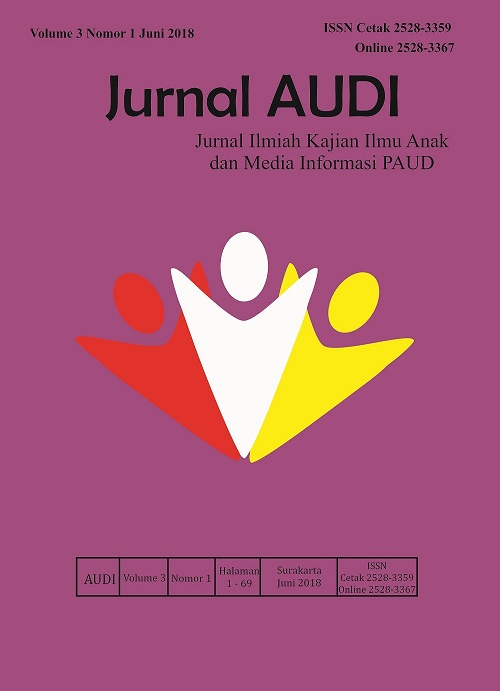PENANGANAN MISBEHAVIOR PADA ANAK USIA DINI YANG MENGANGGU DI KELAS
DOI:
https://doi.org/10.33061/ad.v3i1.2073Kata Kunci:
Handling, Behavioristic, Cognitive, Humanistic, Early ChildhoodAbstrak
Abstrak
Salah satu pengelolaan kelas yang baik adalah terciptanya kelas yang kondusif atau kelas yang mampu menunjukkan bahwa para anak dapat menyimak setiap penjelasan atau arahan dari guru. Namun, seringkali kita mendapatkan ada anak yang seharusnya dapat menyimak atau berbaur dengan yang lain, akan tetapi dia menunjukkan hal-hal yang mungkin dapat mengganggu pembelajaran di kelas. Perilaku mengganggu oleh anak adalah perilaku yang tidak menunjang proses pembelajaran yang dilakukan berulang kali oleh anak di dalam kelas dan hadir berbagai bentuk sesuai dengan kondisi setiap kelas. Perilaku menganggu adalah permasalahan anak di kelas yang tidak bisa dianggap enteng. Strategi untuk menyediakan lingkungan pembelajaran yang efektif tidak hanya meliputi penggunaan waktu kelas yang baik, penciptaan atmosfer yang kondusif bagi ketertarikan terhadap pembelajaran, dan pemberian kesempatan bagi kegiatan yang melibatkan pikiran dan imajinasi siswa, tetapi juga yang lebih penting adalah pencegahan dan tanggapan terhadap perilaku anak yang mengganngu di kelas. Banyak guru yang mengajar di kelas cenderung mengabaikan atau menganggap bahwa hal itu merupakan perilaku anak yang biasa atau guru sebenarnya belum mengetahui cara untuk mengatasi perilaku menganggu tersebut. Untuk itu guru kelas bisa melakukan berbagai tindakan guna mengurangi perilaku menganggu di kelas melalui berbagai pendekatan yaitu behavioristik, kognitif dan humanistik.
Â
Abstract
One good classroom management is the creation of a conducive class or class that can show that children can listen to every explanation or direction from the teacher. However, we often get some children who should be able to listen or mingle with others, but they point out things that might interfere with classroom learning. Disruptive behavior by children is a behavior that does not support the learning process repeatedly done by the child in the classroom and present various forms according to the condition of each class. Disruptive behavior is a child's problem in the class that can not be taken lightly. Strategies to provide an effective learning environment include not only the use of good class time, the creation of an atmosphere conducive to interest in learning, and the provision of opportunities for activities involving the students' minds and imaginations, but also more importantly the prevention and response to the child's behavior hanging out in class. Many teachers who teach in the classroom tend to ignore or assume that it is a child's ordinary behavior or the teacher does not yet know how to overcome such disturbing behavior. For that class, teachers can perform various actions to reduce disruptive behavior in the class through various approaches that are behavioristic, cognitive and humanistic.
Keywords: Handling, Behavioristic, Cognitive, Humanistic, Early Childhood
© 2018 FKIP Universitas Slamet Riyadi
Unduhan
Referensi
Arbuckle., & Little. 2004. Teachers’ Perceptions and Management of Disruptive Classroom Behaviour During the Middle Years (years five to nine). Australian Journal of Educational & Developmental Psychology. Vol 4. Hlm. 59-70.
Arda, & Ocak. (2012). Social Competence and Promoting Alternative Thinking Strategies - PATHS Preschool Curriculum. Educational Sciences: Theory & Practice, 26911698.
Bidell & Deacon. 2010. School Counselors Connecting the Dots Between Disruptive Classroom Behavior and Youth Self-Concept
Cooperkline, J.. 2009. School Absenteeism, Disruptive Classroom Behavior, and Disruptive Family Processes in a Sample of Court- Involved Youth. Thesis
Division of Student Affairs. 2004. Disruptive and Threatening Student Behavior. Booklet. University of Southern California
Dohrn, L., Holian, E., & Kaplan, D. (2001). Improving Social Skills at the Elementary Level through Cooperative Learning and Direct Instruction. Chicago: Saint Xavier University and SkyLight Professional.
Dufrene, B., Doggett, A., Henington, C., & Watson, T. (2007). Functional Assessment and Intervention for Disruptive Classroom Behaviors in Preschool and Head Start Classrooms. J Behav Educ, 368–388.
Eggen, & Kauchak. (2010). Educational Psychology: Windows on Classrooms. Upper Saddle River : Pearson Education, Inc.
Flicker, E., and Hoffman, J. A. 2006. Guiding Children’s Behavior. New York and London: Teacher College Press
Herbert, & Wookey. (2004). Managing Children's Disruptive Behavior. West Sussex: John Wiley and Sons Ltd.
Joyce, B., & Weil, M. (2003). Models of Teaching Fifth Edition, Englewood Cliffs, New Jersey: Prentice-Hall, Inc.
Kohn, A. 1999. Punished by Reward. Boston: Houghton Mifflin.
Pia Todras. 2007. Teachers Perspective of Disruptive Behavior in the Classroom. Dessertation. Faculty of the Chicago School of Professional Psychology
Poteet, J. A. 1984. Assesment in Special Education. New Jersey: Prentice Hall.
Reed, D. F., & Kirkpatrick, C. (1998). Disruptive Students in the Classroom: A Review of the Literature.
Romi, Slomo. (2004). Disruptive behaviour in religious and secular high schools. Journal of Bar-Ilan University. Vol 8. Hlm. 81-91.
Slavin, R. E (2009). Educational Psychology: Theory and Practice (9th Ed). Upper Suddle River: Pearson Education.
Wicaksono, Taufiq Hendra. 2013. Identifikasi Perilaku Menganggu Pada Siswa MAN I Magelang. Skripsi. Yogyakarta: BK FIP UNY
Zimmerman. 1995. The Nature and Consequences of the Classroom Disruption. Dissertation. State University of New York
Unduhan
Diterbitkan
Cara Mengutip
Terbitan
Bagian
Lisensi
Authors who publish this journal agree to the following terms:
- Authors retain copyright and grant the journal right of first publication with the work simultaneously licensed under a Creative Commons Attribution License that allows others to share the work with an acknowledgement of the work's authorship and initial publication in this journal.
- Authors can separately make additional contractual arrangements for non-exclusive distribution published by the journal (e.g., publish it in a book), with an acknowledgement of its initial publication in this journal.
- Authors are allowed and encouraged to send their work via online (e.g., in the institutional repositories or their website) after published by the journal.
















